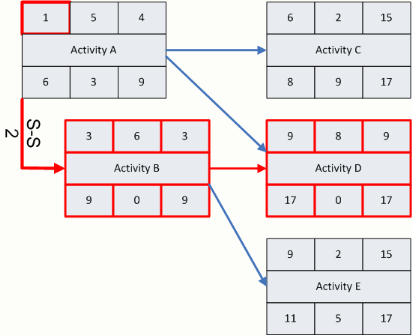start to start logic
Since the Precedence Diagram separates activity definition from sequence, additional types of sequence between activities are easily represented. Once such type of sequence between activities is the “Start-to-Start” sequence. Use the Start-to-Start sequence when the start of the following activities is dependant upon the start of the following activity.
An example use of the Start-to-Start sequence is that of laying underground pipe. In such a project a machine digs a trench in which the pipe is placed. Once the pipe is placed, then the same machine may be used to backfill the trench. An effective project manager may want to schedule this project such that the pipe installation can proceed before the whole trench has been cut. Similarly, the backfill could begin before the entire length of pipe has been installed. To show how the start of one activity can affect the start of another, use the Start-to-Start sequence.
Notice that the logic sequence between activities using the Start-to-Start sequence may include a time component. For example, we cannot start the pipe installation at exactly the same as the start of the trenching operation. The first activity must get “ahead” a few days, before the piping activity can begin. Adding a time duration to the sequence between activities is a major innovation associated with the Precedence Diagram.
The diagram below shows how to draw the Start-to-Start sequence. To calculate the Early Start Time of an activity with a prior Start-to-Start sequence, identify the possible incoming value of an activity’s Early Start Time as the Early Start Time of the preceding activity plus the “lead” duration identified with the decription of the sequence between activities.

Regardless of the type of incoming logic, the sequential (i.e. Finish-to-Start) or the parallel (i.e. Start-to-Start), the value of an activities Early Start Time is the latest of all incoming preceding times. These dates may be earlier activities’ Early Finish Times as well as the Start-to-Start plus lead durations.
In the example schedule fragments below, notice how the Early Start Time of the following activity is set based on the preceding Start-to-Start sequence. As a result the critical path begins with the start of Activity A.
